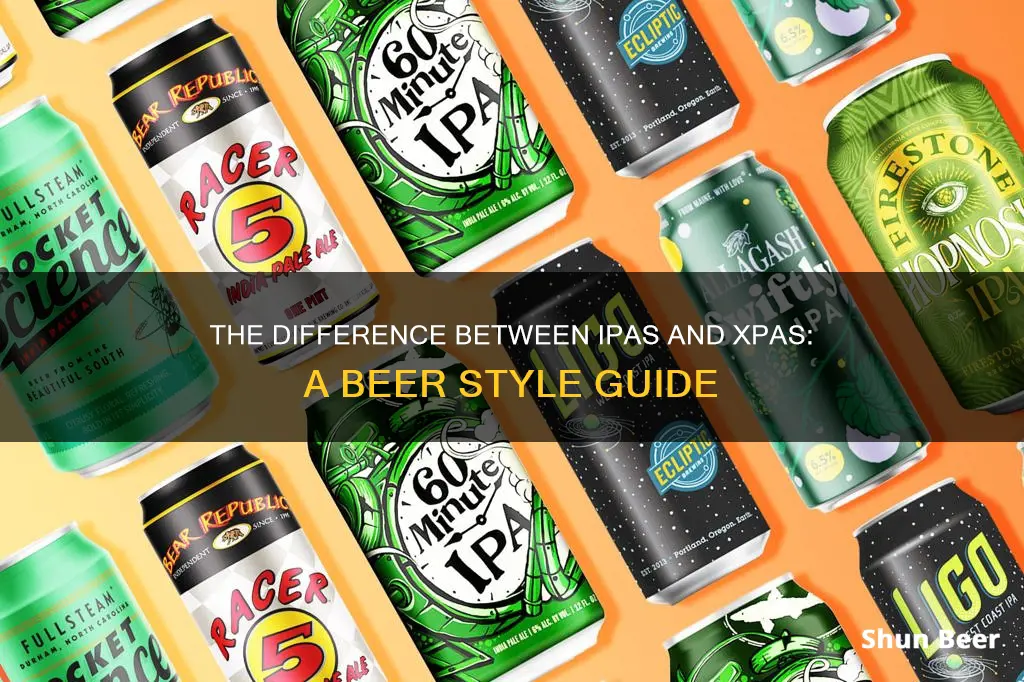
India Pale Ales (IPAs) and Extra Pale Ales (XPAs) are two types of pale ales, a broad category of beers that are usually gold or copper in colour with a dry finish and a crisp hop flavour. IPAs are similar to pale ales but traditionally have more hops and a higher alcohol content (between 5.6% and 7.9%) as a result of being shipped to India during the colonial era. On the other hand, XPAs are a style of beer that sits somewhere between an American Pale Ale (APA) and an IPA, with a higher alcohol content than a pale ale but lower than an IPA.
| Characteristics | Values |
|---|---|
| IPA meaning | Indian Pale Ale |
| IPA origin | England, 1840s |
| IPA alcohol content | 5.6–7.9% ABV |
| XPA meaning | Extra Pale Ale |
| XPA alcohol content | Higher than Pale Ale, but lower than IPA |
What You'll Learn

History of IPAs and XPAs
The history of IPAs and XPAs is a story of innovation and a testament to the enduring popularity of these beer styles.
India Pale Ale (IPA), as the name suggests, has its roots in the historical trade connections between Britain and India during the colonial era. In the 18th century, British brewers began exporting a strongly-hopped pale ale to India, which gained popularity among East India Company traders. The early IPAs were brewed with coke-fired malt, resulting in a paler colour, and had slightly higher alcohol content compared to other beers of that time.
By the 1860s, IPAs were widely brewed in England and had become a popular product, with some brewers even dropping the "India" from their name. The style was also exported to other colonial countries, such as Australia and New Zealand, further spreading its reach.
In the 20th century, the IPA underwent a revival, with craft brewers in the United States seeking out old beer styles and experimenting with new ingredients and techniques. This led to the creation of various IPA sub-styles, such as Black IPA, Brut IPA, and New England IPA, each with its unique characteristics.
The Extra Pale Ale (XPA), on the other hand, is a more recent addition to the world of beer. XPAs are described as sitting between American Pale Ales (APA) and IPAs in terms of flavour and alcohol content. They first appeared in the craft brewing scene in Oregon, USA, in 2008, with the "X" originally standing for "experimental" as brewers played with new hop varieties. Over time, the "X" evolved to signify "extra", indicating a paler colour, extra hops, or other unique characteristics.
XPAs have gained significant popularity in Australia, with many local breweries embracing the style and adding their own twists. The appeal of XPAs lies in their ability to offer a well-rounded, less intense beer experience while still delivering on flavour and aroma. The style continues to evolve, with no official guidelines, allowing brewers creative freedom and consumers a diverse range of beers to explore.
Guinness' Surprising Health Benefits Over Other Beers
You may want to see also

Taste and flavour profiles
IPAs, or India Pale Ales, are known for their aggressive hoppiness, with flavour notes that can include bitter, floral, earthy, citrusy, piney, and fruity. The bitterness of an IPA comes from the hops, which were originally added to balance out the residual sugars in beer to avoid it being too sweet. The hops also have antimicrobial properties.
IPAs can be further divided into categories, such as American, Belgian, English, Imperial (Double), Black, and Rye. American IPAs can be divided into East Coast and West Coast IPAs. West Coast IPAs tend to be more aggressively hoppy and powerfully bitter, with classic Northwest hop flavours like citrus, pine, florals, and strong bitterness. East Coast IPAs are more balanced, with a stronger malt component to match the stronger hops. English IPAs are less intensely hoppy, with more of a balance between malt and hop flavour and bitterness. They may also showcase some toasty and bready malt notes. Belgian IPAs are a recent hybrid style inspired by the popularity of American IPAs. They are heavily hopped, often with American hop varieties, and differentiated by the use of Belgian yeast strains in bottle conditioning. Imperial IPAs, or Double IPAs, are like standard IPAs but turned up, with a higher alcohol content and even more hops. Black IPAs have the roastiness and depth turned down, with a proportion of roasted malt lending chocolate, coffee, and other dark notes to the overall flavour. Rye IPAs are a subcategory of American IPAs with some rye added to the malt, amplifying the citrusy, piney hops flavour and adding complexity to the malt.
XPAs, or Extra Pale Ales, are a style of beer that sits somewhere between an American Pale Ale (APA) and an IPA. They are lighter in colour than English pale ales and have fewer caramel flavours. XPAs typically have a moderate to strong hop aroma with citrusy hop characters. The maltiness is less predominant in XPAs, allowing the hop characteristics to shine through. The bitterness of an XPA is less than that of an IPA, but more than an APA.
Guinness Beer Proof: The Science Behind the Dark Drink
You may want to see also

Alcohol content
The alcohol content of beers varies depending on the type and brand. Classic pale ales typically start at around 5% ABV, while more boutique brews can go up to 12%. The alcohol content of an IPA, or Indian Pale Ale, is typically above 6%, while an APA, or American Pale Ale, is usually below 5%. IIPAs, or Imperial Indian Pale Ales, have an alcohol content above 7.5%.
XPA, or Extra Pale Ale, is a style of beer that sits somewhere between an APA and an IPA. The alcohol content of an XPA can vary, but it is generally above 5%. For example, Coopers XPA has an ABV of 5.2%. Other XPAs may have a higher alcohol content, such as the one brewed by Riders Brewing Company, which has an ABV of 5.8%.
The alcohol content of a beer is just one factor that contributes to its overall character and appeal. Other factors include the type of hops used, the maltiness, and the presence of citrusy or fruity flavours.
Understanding IPA Beer Allergies and Their Causes
You may want to see also

Popularity in Australia
The Extra Pale Ale, or XPA, is a style of beer that has captured the Australian consumer. It is an American adaptation of English pale ale, sitting somewhere between an American Pale Ale (APA) and an India Pale Ale (IPA). It is lighter in colour than English pale ale and has fewer caramel flavours. The XPA is brewed to have all-year-round appeal and is open to interpretation by brewers, making it a beer that appeals to both craft beer aficionados and those looking for gateway beers.
The XPA has a moderate to strong hop aroma with citrusy hop characters, without the bitterness of an IPA, making it very appealing to Australian consumers. This is reflected in the fact that XPA styles have won key awards, including top gongs at the Australian Liquor Industry Awards and the GABS Hottest 100. Many independent brewers are adopting the style and giving it their own unique twist, which is vital for a strong beer category overall. Australian consumers are increasingly engaging with the beers crafted and released by independent breweries.
One example of an XPA that has gained popularity in Australia is the Coopers XPA, launched by Australia's largest independent brewer. The Coopers XPA highlights the citrus character of American hops, balancing it with malt to create a smooth and very drinkable hoppy beer. It has bright citrus undertones with aromas of grapefruit, lemon, and a hint of mandarin, and an ABV of 5.2%. The beer has been well-received, with Coopers experiencing a record number of sales and high demand through hotels and bars, leading to the decision to release the beer in can format for bottleshops in Australia.
Another popular XPA in Australia is the Wolf of the Willows XPA, which serves as a great introduction to the style. Bondi's Beach Beer is another XPA with a drier finish, perfect for extra refreshment while sipping by the ocean. For a more intense experience, there's Doug's Courage from Hemingway's, which offers a more intense experience that bends the rules of the typical XPA style.
Probiotics in Beer: The Truth About IPAs
You may want to see also

The brewing process
Mashing
The first step in the brewing process is mashing, where malted barley is soaked in warm water to convert the starches into sugars. The temperature and duration of this step will vary depending on the style of beer being brewed.
Boiling
After mashing, the resulting liquid (wort) is boiled. During boiling, hops are added at different times to contribute to the flavour, aroma, and bitterness of the beer. The type and amount of hops added will vary depending on the style of beer. For example, IPAs are known for their strong hop flavour and aroma, while XPAs have a more balanced flavour profile.
Fermentation
After boiling, the wort is cooled and yeast is added to begin the fermentation process. Fermentation is when the sugars in the wort are converted into alcohol. The type of yeast and fermentation temperature will vary depending on the style of beer. For example, XPAs typically have a cleaner fermentation with fewer by-products.
Aging and Packaging
After fermentation, the beer is aged to allow the flavours to mature and develop. The aging process can vary in duration and may involve different techniques such as dry-hopping, where additional hops are added to the beer during aging. Finally, the beer is packaged into kegs or cans and distributed.
The Birth of Guinness: A Historical Perspective
You may want to see also
Frequently asked questions
IPA stands for Indian Pale Ale. The name comes from the beer being exported to British colonies in places like India during the 19th century.
IPAs are a broad category of pale ales with a stronger, more bitter and hop-forward flavour. They usually have a higher alcohol content than pale ales (5.6-7.9% ABV).
XPA stands for Extra Pale Ale. It's a style of beer that sits somewhere between an American Pale Ale (APA) and an IPA. XPAs usually have a slightly higher alcohol content than pale ales but lower than IPAs.
IPAs are known for their strong, bitter taste and higher alcohol content. In comparison, XPAs are lighter in colour, have less caramel flavour, and are less bitter than IPAs.







